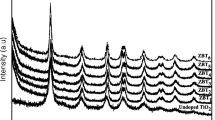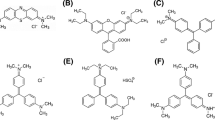Abstract
It has been reported that bipyramidal anatase TiO2 with {101}-exposed facets (AT170) results in outstanding photocatalytic performance. However, its activity decayed significantly and comparatively lower than that of commercial P25 after 20 min. Further studies and calculations showed that the methylene blue (MB) degradation rate constants for AT170 were time dependent and decrease of k values with time. Besides, the results of XPS, EA and TEM could clearly elucidate that the active sites of catalysts were blocked by the carbon buildup and covered on the surface creating the metal–carbon bonding on the catalysts. These observation strongly implied the existence of the poisoning effect of AT170 during photocatalytic processes. Also, the surface area values of P25 and AT170 were found to be 46.83 and 3.56 m2/g respectively. It was suggested that the catalyst poisoning effect could be prevented or controlled by increasing the surface area of the catalyst. Besides of surface area, zeta potential was also found to be served as the important factor determining the photocatalytic performance toward organic dyes due to the attraction/repulsion of electrostatic interaction. The zeta potential values of P25 and AT170 were found to be − 3.8 and − 32.9 mV respectively, which can adsorb cationic MB dyes on the negative charged surface through attraction of electrostatic interaction successively enhancing the degradation performance. It strongly indicates that both surface area and zeta potential play vital roles in photocatalytic degradation toward organic dyes and affect the rate constants.




Similar content being viewed by others
References
Hachem C, Bocquillon F, Zahraa O, Bouchy M (2001) Decolourization of textile industry wastewater by the photocatalytic degradation process. Dyes Pigm 49(2):117–125
Chequer FMD, de Oliveira GAR, Ferraz ERA, Cardoso JC, Zanoni MVB, de Oliveira DP (2013) Textile dyes: dyeing process and environmental impact. In: Gunay M (ed) Eco-friendly textile dyeing and finishing. InTech, Rijeka
McMullan G, Meehan C, Conneely A, Kirby N, Robinson T, Nigam P, Banat I, Marchant R, Smyth W (2001) Microbial decolourisation and degradation of textile dyes. Appl Microbiol Biotechnol 56(1–2):81–87
Carmen Z, Daniela S (2012) Textile organic dyes—characteristics, polluting effects and separation/elimination procedures from industrial effluents—a critical overview. In: Mostragt-Szlichtyng A, Puzyn T (eds) Organic pollutants ten years after the Stockholm convention-environmental and analytical update. InTech, Rijeka
Martinez-Huitle CA, Ferro S (2006) Electrochemical oxidation of organic pollutants for the wastewater treatment: direct and indirect processes. Chem Soc Rev 35(12):1324–1340
Kadirova ZC, Katsumata K-I, Isobe T, Matsushita N, Nakajima A, Okada K (2013) Adsorption and photodegradation of methylene blue by iron oxide impregnated on granular activated carbons in an oxalate solution. Appl Surf Sci 284:72–79
Liu M, Qiu X, Miyauchi M, Hashimoto K (2013) Energy-level matching of Fe (III) ions grafted at surface and doped in bulk for efficient visible-light photocatalysts. J Am Chem Soc 135(27):10064–10072
Xia S, Zhang L, Pan G, Qian P, Ni Z (2015) Photocatalytic degradation of methylene blue with a nanocomposite system: synthesis, photocatalysis and degradation pathways. Phys Chem Chem Phys 17(7):5345–5351
Liu J, Shu T, Su L, Zhang X, Serpe MJ (2018) Synthesis of poly (N-isopropylacrylamide)-co-(acrylic acid) microgel-entrapped CdS quantum dots and their photocatalytic degradation of an organic dye. RSC Adv 8(30):16850–16857
Liu B, Chen HM, Liu C, Andrews SC, Hahn C, Yang P (2013) Large-scale synthesis of transition-metal-doped TiO2 nanowires with controllable overpotential. J Am Chem Soc 135(27):9995–9998
Moustakas N, Katsaros F, Kontos A, Romanos GE, Dionysiou D, Falaras P (2014) Visible light active TiO2 photocatalytic filtration membranes with improved permeability and low energy consumption. Catal Today 224:56–69
Lyu H, Hisatomi T, Goto Y, Yoshida M, Higashi T, Katayama M, Takata T, Minegishi T, Nishiyama H, Yamada T (2019) An Al-doped SrTiO3 photocatalyst maintaining sunlight-driven overall water splitting activity for over 1000 h of constant illumination. Chem Sci 10(11):3196–3201
He X, Zhang C (2019) Recent advances in structure design for enhancing photocatalysis. J Mater Sci 54(12):8831–8851. https://doi.org/10.1007/s10853-019-03417-8
Yang MH, Tsai MC, Chang YW, Chang YC, Chiu HT, Lee CY (2013) Photodegradation by a heterogeneous mixture of micro-sized anatase and truncated rhomboid anatase hollow spheres. ChemCatChem 5(7):1871–1876
Armaković S, Armaković S, Finčur N, Šibul F, Vione D, Šetrajčić J, Abramović B (2015) Influence of electron acceptors on the kinetics of metoprolol photocatalytic degradation in TiO2 suspension. A combined experimental and theoretical study. RSC Adv 5(67):54589–54604
An M, Li L, Cao Y, Ma F, Liu D, Gu F (2019) Coral reef-like Pt/TiO2-ZrO2 porous composites for enhanced photocatalytic hydrogen production performance. Mol Catal 475:110482
Khan MM, Ansari SA, Pradhan D, Ansari MO, Lee J, Cho MH (2014) Band gap engineered TiO2 nanoparticles for visible light induced photoelectrochemical and photocatalytic studies. J Mater Chem A 2(3):637–644
Chen W-F, Koshy P, Sorrell CC (2016) Effects of film topology and contamination as a function of thickness on the photo-induced hydrophilicity of transparent TiO2 thin films deposited on glass substrates by spin coating. J Mater Sci 51(5):2465–2480
Jiang Y, Chen W-F, Koshy P, Sorrell CC (2019) Enhanced photocatalytic performance of nanostructured TiO2 thin films through combined effects of polymer conjugation and Mo-doping. J Mater Sci 54(7):5266–5279. https://doi.org/10.1007/s10853-018-03271-0
Yang M-H, Chen P-C, Tsai M-C, Chen T-T, Chang I-C, Chiu H-T, Lee C-Y (2013) Alkali metal ion assisted synthesis of faceted anatase TiO2. CrystEngComm 15(15):2966–2971
Lee J-Y, Tsai M-C, Chen P-C, Chen T-T, Chan K-L, Lee C-Y, Lee R-K (2015) Thickness effects on light absorption and scattering for nanoparticles in the shape of hollow spheres. J Phys Chem C 119(46):25754–25760
Li J, Yu Y, Chen Q, Li J, Xu D (2010) Controllable synthesis of TiO2 single crystals with tunable shapes using ammonium-exchanged titanate nanowires as precursors. Cryst Growth Des 10(5):2111–2115
Lachheb H, Puzenat E, Houas A, Ksibi M, Elaloui E, Guillard C, Herrmann J-M (2002) Photocatalytic degradation of various types of dyes (Alizarin S, Crocein Orange G, Methyl Red, Congo Red, Methylene Blue) in water by UV-irradiated titania. Appl Catal B 39(1):75–90
Houas A, Lachheb H, Ksibi M, Elaloui E, Guillard C, Herrmann J-M (2001) Photocatalytic degradation pathway of methylene blue in water. Appl Catal B 31(2):145–157
Lente G (2018) Facts and alternative facts in chemical kinetics: remarks about the kinetic use of activities, termolecular processes, and linearization techniques. Curr Opin Chem Eng 21:76–83
Zhou N, Polavarapu L, Gao N, Pan Y, Yuan P, Wang Q, Xu Q-H (2013) TiO2 coated Au/Ag nanorods with enhanced photocatalytic activity under visible light irradiation. Nanoscale 5(10):4236–4241
Liu M, Piao L, Lu W, Ju S, Zhao L, Zhou C, Li H, Wang W (2010) Flower-like TiO2 nanostructures with exposed 001 facets: facile synthesis and enhanced photocatalysis. Nanoscale 2(7):1115–1117
Ahmed M, El-Katori EE, Gharni ZH (2013) Photocatalytic degradation of methylene blue dye using Fe2O3/TiO2 nanoparticles prepared by sol–gel method. J Alloys Compd 553:19–29
Rauf MA, Meetani MA, Khaleel A, Ahmed A (2010) Photocatalytic degradation of methylene blue using a mixed catalyst and product analysis by LC/MS. Chem Eng J 157(2–3):373–378
Matos J, García A, Zhao L, Titirici MM (2010) Solvothermal carbon-doped TiO2 photocatalyst for the enhanced methylene blue degradation under visible light. Appl Catal A 390(1–2):175–182
Liu GG, Han K, Zhou YH, Ye HQ, Zhang X, Hu JB, Li XJ (2018) Facile synthesis of highly dispersed Ag doped graphene oxide/titanate nanotubes as a visible light photocatalytic membrane for water treatment. ACS Sustain Chem Eng 6(5):6256–6263. https://doi.org/10.1021/acssuschemeng.8b00029
Shanmugam M, Alsalme A, Alghamdi A, Jayavel R (2015) Enhanced photocatalytic performance of the graphene-V2O5 nanocomposite in the degradation of methylene blue dye under direct sunlight. ACS Appl Mater Interfaces 7(27):14905–14911
Zhu M, Zhai C, Qiu L, Lu C, Paton AS, Du Y, Goh MC (2015) New method to synthesize S-doped TiO2 with stable and highly efficient photocatalytic performance under indoor sunlight irradiation. ACS Sustain Chem Eng 3(12):3123–3129
Pitre SP, McTiernan CD, Ismaili H, Scaiano JC (2014) Metal-free photocatalytic radical trifluoromethylation utilizing methylene blue and visible light irradiation. ACS Catal 4(8):2530–2535
Xu C, Rangaiah G, Zhao X (2014) Photocatalytic degradation of methylene blue by titanium dioxide: experimental and modeling study. Ind Eng Chem Res 53(38):14641–14649
Oudar J (1980) Sulfur adsorption and poisoning of metallic catalysts. Catal Rev: Sci Eng 22(2):171–195
Rosso I, Garrone E, Geobaldo F, Onida B, Saracco G, Specchia V (2001) Sulphur poisoning of LaMn1−xMgxO3 catalysts for natural gas combustion. Appl Catal B 30(1):61–73
Choi Y, Umebayashi T, Yoshikawa M (2004) Fabrication and characterization of C-doped anatase TiO2 photocatalysts. J Mater Sci 39(5):1837–1839
Göpel W, Anderson J, Frankel D, Jaehnig M, Phillips K, Schäfer J, Rocker G (1984) Surface defects of TiO2 (110): a combined XPS XAES and ELS study. Surf Sci 139(2–3):333–346
Wiedmer D, Sagstuen E, Welch K, Haugen HJ, Tiainen H (2016) Oxidative power of aqueous non-irradiated TiO2-H2O2 suspensions: methylene blue degradation and the role of reactive oxygen species. Appl Catal B 198:9–15
Hossan MS, Ochiai B (2018) Preparation of TiO2-poly (3-chloro-2-hydroxypropyl methacrylate) nanocomposite for selective adsorption and degradation of dyes. Technologies 6(4):92
Azeez F, Al-Hetlani E, Arafa M, Abdelmonem Y, Nazeer AA, Amin MO, Madkour M (2018) The effect of surface charge on photocatalytic degradation of methylene blue dye using chargeable titania nanoparticles. Sci Rep 8(1):7104
Mozia S, Tomaszewska M, Morawski AW (2005) Photocatalytic degradation of azo-dye Acid Red 18. Desalination 185(1–3):449–456
Suttiponparnit K, Jiang J, Sahu M, Suvachittanont S, Charinpanitkul T, Biswas P (2011) Role of surface area, primary particle size, and crystal phase on titanium dioxide nanoparticle dispersion properties. Nanoscale Res Lett 6(1):27
Lim TH, Jeong SM, Kim SD, Gyenis J (2000) Photocatalytic decomposition of NO by TiO2 particles. J Photochem Photobiol A 134(3):209–217
Acknowledgements
The authors would like to thank Ministry of Science and Technology of Taiwan (ROC), for financially supporting this research under Contract No. MOST 105-2119-M-007-021. K. T. Li Foundation for Development of Science and Technology is appreciated for the editorial assistance.
Author information
Authors and Affiliations
Corresponding author
Ethics declarations
Conflict of interest
There are no conflict to declare.
Additional information
Publisher's Note
Springer Nature remains neutral with regard to jurisdictional claims in published maps and institutional affiliations.
Electronic supplementary material
Below is the link to the electronic supplementary material.
Rights and permissions
About this article
Cite this article
Chan, KL., Lin, WH., Chen, FJ. et al. Photocatalytic performance of bipyramidal anatase TiO2 toward the degradation organic dyes and its catalyst poisoning effect. Reac Kinet Mech Cat 130, 531–546 (2020). https://doi.org/10.1007/s11144-020-01759-y
Received:
Accepted:
Published:
Issue Date:
DOI: https://doi.org/10.1007/s11144-020-01759-y




